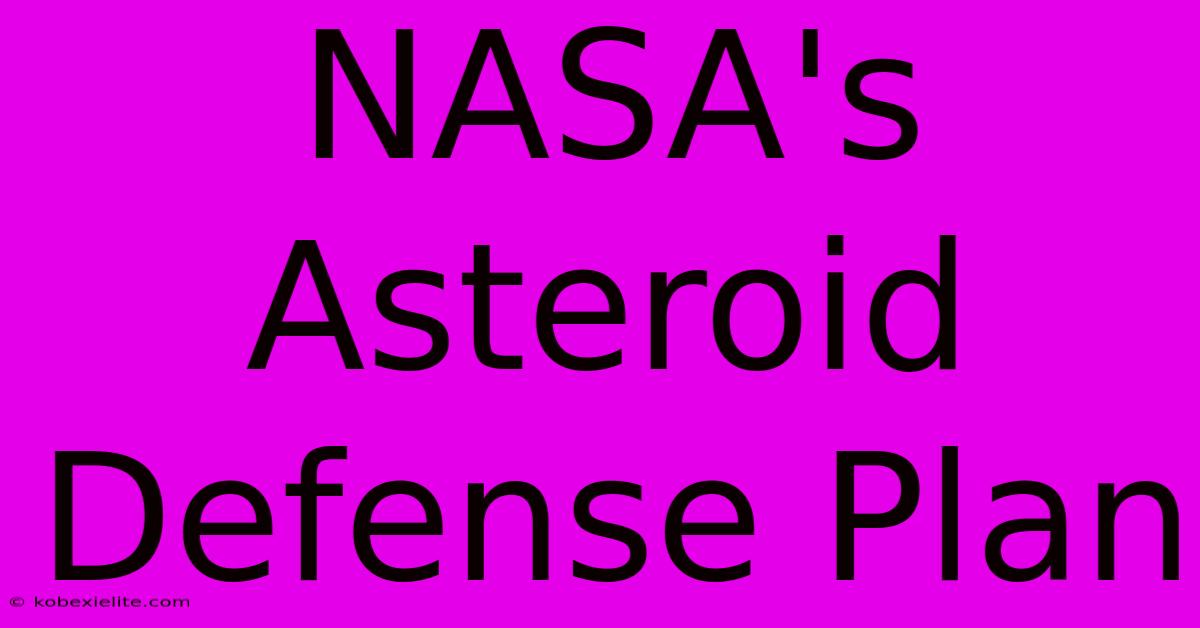NASA's Asteroid Defense Plan

Discover more detailed and exciting information on our website. Click the link below to start your adventure: Visit Best Website mr.cleine.com. Don't miss out!
Table of Contents
NASA's Asteroid Defense Plan: Protecting Earth from Cosmic Threats
The vast expanse of space, while inspiring awe, also presents potential dangers. Among these, asteroid impacts represent a significant, albeit low-probability, threat to our planet. Recognizing this risk, NASA has developed a comprehensive asteroid defense plan, employing a multi-pronged approach to detection, tracking, and mitigation. This plan isn't about Hollywood-style explosions; it's a carefully considered strategy based on scientific understanding and technological advancements.
Detecting the Threat: Finding Asteroids Before They Find Us
The first line of defense is early detection. NASA's Planetary Defense Coordination Office (PDCO) plays a crucial role in this process. They oversee various projects dedicated to identifying and tracking near-Earth objects (NEOs), which include asteroids and comets that pass relatively close to Earth's orbit.
Key Technologies in Asteroid Detection:
- Ground-based Telescopes: Numerous telescopes worldwide constantly scan the skies, searching for the faint light signatures of NEOs. These observatories use sophisticated software to analyze the data and identify potential threats.
- Space-based Telescopes: Telescopes in space, like the NEOWISE mission (now decommissioned but its data remains valuable), offer a unique vantage point, providing clearer views and detecting objects that might be missed from Earth.
- Citizen Science Initiatives: Projects like Asteroid Grand Challenge involve citizen scientists helping to analyze telescope data, significantly expanding the search capacity.
The Importance of Early Detection: Early detection is paramount. The more time we have before a potential impact, the more options we have for mitigation.
Assessing the Risk: Understanding the Threat Level
Once an NEO is detected, the next step is to assess its potential risk. Scientists use sophisticated calculations to determine the object's trajectory, size, and composition. This allows them to predict the probability of an impact and the potential consequences.
The Palermo Technical Impact Hazard Scale:
This scale quantifies the risk posed by an NEO, considering factors like the object's size, its probability of impact, and the time until a potential collision. A higher score indicates a greater risk.
Understanding the Risks: Accurate risk assessment is crucial for prioritizing mitigation efforts and allocating resources effectively.
Mitigation Strategies: Deflecting or Destroying Asteroids
If an NEO poses a significant threat, NASA has several mitigation strategies under consideration. These are not mutually exclusive; a combination of techniques might be necessary depending on the specific circumstances.
Kinetic Impactor:
This method involves sending a spacecraft to collide with the asteroid, altering its trajectory subtly but significantly over time. NASA's DART (Double Asteroid Redirection Test) mission successfully demonstrated this technique in 2022.
Gravity Tractor:
This technique utilizes the gravitational pull of a spacecraft to slowly nudge the asteroid off course over an extended period. This method requires less force than a kinetic impactor, but it necessitates longer lead times.
Nuclear Option:
While often depicted in movies, nuclear deflection is a last resort. The strategy involves using a nuclear explosion not to destroy the asteroid (which could create multiple smaller, potentially hazardous fragments), but to impart a significant impulse to change its course. This option requires careful planning and consideration of potential consequences.
Choosing the Right Method: The selection of the optimal mitigation strategy depends on factors such as the asteroid's size, composition, and the time available before a potential impact.
International Collaboration: A Global Effort
Addressing the asteroid threat requires a collaborative global effort. NASA works closely with international space agencies and scientific communities to share data, coordinate observations, and develop effective mitigation strategies. This international partnership is crucial for ensuring the safety and security of our planet.
The Future of Asteroid Defense: Continued Research and Development
NASA's asteroid defense plan is an ongoing endeavor. Continuous research and development are crucial for improving detection capabilities, refining mitigation techniques, and ensuring that we are well-prepared to face this potential challenge. The future of asteroid defense involves further technological advancements, improved international cooperation, and a commitment to proactive planetary protection. This isn't just about preventing a catastrophic event; it's about securing the future of our planet.

Thank you for visiting our website wich cover about NASA's Asteroid Defense Plan. We hope the information provided has been useful to you. Feel free to contact us if you have any questions or need further assistance. See you next time and dont miss to bookmark.
Featured Posts
-
Recent Google Search Skull Shaver
Feb 13, 2025
-
Confirmed Teams Sporting Vs Dortmund
Feb 13, 2025
-
Liverpool Vs Everton Match Result And Reaction
Feb 13, 2025
-
India Vs England 3rd Odi Axar Out
Feb 13, 2025
-
Watch Juventus Vs Psv Champions League
Feb 13, 2025
